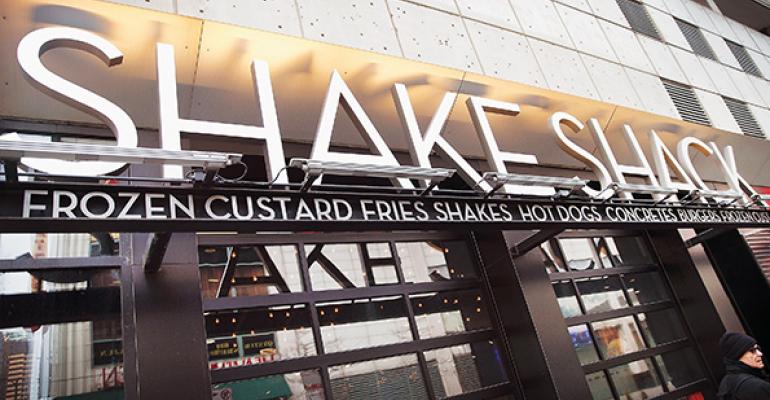Shake Shack Inc. on Monday told investors that it expects sales to slow down in 2016 while labor costs rise because of the chain’s decision to increase pay for its workers this year.
Investors didn’t like it. Despite strong same-store sales in 2015, along with lower food and labor costs, the company’s stock plunged more than 11 percent on Tuesday.
“We want to be conservative, as we always have been,” Shake Shack CEO Randy Garutti said during the company’s earnings call late Monday afternoon. “We’re going to remain conservative at this stage.”
Company executives have sought to temper Wall Street expectations from the day it went public to immense fanfare in January a year ago. They continued trying to temper expectations this week when the chain kept its sales predictions modest for the year.
Shake Shack said that same-store sales would rise 2.5 percent to 3 percent for the full year, which would be a significant slowdown from the 13.3 percent in 2015, including 11 percent in the fourth quarter ended Dec. 30.
In short, executives said that the strong traffic the chain’s restaurants experienced in 2015 would be difficult to sustain this year. “We do expect traffic to continue to be positive,” Shake Shack CFO Jeff Uttz said during the call. “But we don’t think current numbers are sustainable for the long term.”
The expected sales slowdown come despite the chain adding its Chicken Shack sandwich this year at all of its locations. Company executives said they’ve been pleased with the performance of the sandwich thus far — it’s a top five product, they said, at each location.
They hope the sandwich will add sales, traffic and average check while lowering food costs. But they also were conservative in their predictions about the impact of that product.
“It’s too early to know what chicken will mean for us systemwide,” Garutti said.
Wall Street has been worried about sales slowdowns at fast-casual chains, and investors have routinely sold off on chains that make such predictions.
Tuesday’s sell-off more than wiped out recent gains in Shake Shack stock. The stock had been up more than 6 percent as of close on Monday — all restaurant stocks were up 4.2 percent on the year, according to the NRN Restaurant Index.
The stock, now trading below $38 a share, is well off the chain’s all-time high of $96.75, reached in May last year.
Another issue investors were concerned about was labor costs. Shake Shack increased wages for workers heading into this year, to a range of $10.50 to $12 an hour, while team leaders and trainers could make $12 to $15 an hour.
Company executives believe the higher pay will ultimately translate into improved service and productivity that will ultimately generate more revenues. “We believe paying our team well will drive more sales and help us attract and retain people,” Garutti said.
But higher labor also equates to higher costs. Shake Shack’s strong sales in 2015 enabled the company to leverage its labor costs — labor costs were just 25 percent of sales in the fourth quarter, down from 26.3 percent in the same period a year ago.
Company executives expect that percentage to increase this year with the higher pay rates. “We were able to leverage labor in 2015,” Uttz said. “We don’t expect that to continue into 2016. We expect labor to increase.” He said the labor line would increase 100 to 150 basis points.
“We’re staying ahead of the minimum wage by paying $12 an hour,” he added.
Still, company executives touted what they called an extraordinary year, one that began with the January initial-public offering along with incredible enthusiasm for the brand among consumers, even in other countries. Some 400 people waited overnight for the opening of the Tokyo in November.
“We have just barely gotten started,” Garutti said. The chain now has 84 locations systemwide, 44 of them domestic, company-owned units and another 35 international licensed units to go along with five locations licensed in the U.S.
Company executives added 13 new locations domestically in 2015 and expect to add a number of new markets in 2016, including Los Angeles, Dallas and Minneapolis as well as Arizona, opened last month.
The additional locations and markets come with a more flexible development strategy in which locations can go into just about any type of location, including strip malls, urban and suburban locations and stand-alone units.
“Our real estate opportunities are stronger than ever,” Garutti said. “We remain confident in our ability to execute on our growth plans.”
Contact Jonathan Maze at [email protected]
Follow him on Twitter: @jonathanmaze





